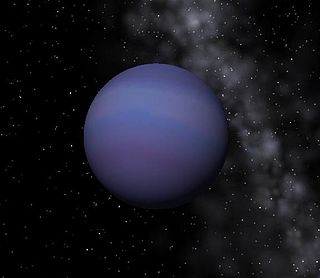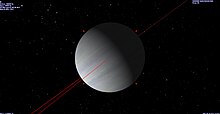
Gliese 876 is a red dwarf star 15.2 light-years away from Earth in the constellation of Aquarius. It is one of the closest known stars to the Sun confirmed to possess a planetary system with more than two planets, after GJ 1061, YZ Ceti, Tau Ceti, and Wolf 1061; as of 2018, four extrasolar planets have been found to orbit the star. The planetary system is also notable for the orbital properties of its planets. It is the only known system of orbital companions to exhibit a near-triple conjunction in the rare phenomenon of Laplace resonance. It is also the first extrasolar system around a normal star with measured coplanarity. While planets b and c are located in the system's habitable zone, they are giant planets believed to be analogous to Jupiter.
HD 169830 is a star in the southern constellation of Sagittarius. It has a yellow-white hue and is dimly visible to the naked eye with an apparent visual magnitude of +5.90. The star is located at a distance of 120 light years from the Sun based on parallax. It is drifting closer with a radial velocity of −17.3 km/s, and is predicted to come as close as 20.7 ly (6.4 pc) in 2.08 million years. HD 169830 is known to be orbited by two large Jupiter-like exoplanets.
HD 38529 is a binary star approximately 138 light-years away in the constellation of Orion.
HD 196885 is a binary star system in the northern constellation of Delphinus. It comprise a pair of stars HD 196885 A and HD 196885 B on a 69-years eccentric orbit.
HD 1237 is a binary star system approximately 57 light-years away in the constellation of Hydrus.

Iota Horologii b, often catalogued HR 810 b, is an extrasolar planet approximately 56.5 light-years away in the constellation of Horologium. Iota Horologii b has a minimum mass 2.26 times that of Jupiter; astrometric measurements from Gaia suggest it has a true mass of 6.2 MJ.

16 Cygni Bb or HD 186427 b is an extrasolar planet approximately 69 light-years away in the constellation of Cygnus. The planet was discovered orbiting the Sun-like star 16 Cygni B, one of two solar-mass (M☉) components of the triple star system 16 Cygni in 1996. It orbits its star once every 799 days and was the first eccentric Jupiter and planet in a double star system to be discovered. The planet is abundant in lithium.
Upsilon Andromedae d, formally named Majriti, is a super-Jupiter exoplanet orbiting within the habitable zone of the Sun-like star Upsilon Andromedae A, approximately 44 light-years away from Earth in the constellation of Andromeda. Its discovery made it the first multiplanetary system to be discovered around a main-sequence star, and the first such system known in a multiple star system. The exoplanet was found by using the radial velocity method, where periodic Doppler shifts of spectral lines of the host star suggest an orbiting object.

14 Herculis b or 14 Her b is an exoplanet approximately 58.4 light-years away in the constellation of Hercules. The planet was found orbiting the star 14 Herculis, with a mass that would make the planet a Jovian planet roughly the same size as Jupiter but much more massive. It was discovered in July 1998 by the Geneva Extrasolar Planet Search team. The discovery was formally published in 2003. At the time of discovery it was the extrasolar planet with the longest orbital period, though longer-period planets have subsequently been discovered.
Pi Mensae, also known as HD 39091, is a yellow dwarf star in the constellation of Mensa. This star has a high proper motion. The apparent magnitude is 5.67, which can be visible to the naked eye in exceptionally dark, clear skies. It is nearly 60 light-years away. The star is slightly larger than the Sun in terms of mass, size, luminosity, temperature and metallicity, and is about 730 million years younger. It hosts three known planets.

109 Piscium b is a long-period extrasolar planet discovered in orbit around 109 Piscium. It is about 5.74 times the mass of Jupiter and is likely to be a gas giant. As is common for long-period planets discovered around other stars, it has an orbital eccentricity greater than that of Jupiter.
Gliese 86 is a K-type main-sequence star approximately 35 light-years away in the constellation of Eridanus. It has been confirmed that a white dwarf orbits the primary star. In 1998 the European Southern Observatory announced that an extrasolar planet was orbiting the star.
HD 176051 is a spectroscopic binary star system approximately 49 light years away from Earth in the constellation Lyra. The pair orbit with a period of 22,423 days and an eccentricity of 0.25. Compared to the Sun, they have a somewhat lower proportion of elements more massive than helium. Their individual masses are estimated at 1.07 and 0.71 solar masses (M☉). The system is moving closer to the Sun with a radial velocity of −47 km/s and will reach perihelion in about 269,000 years when it comes within roughly 17 ly (5.1 pc) of the Sun.
HD 117207 is a star in the southern constellation Centaurus. With an apparent visual magnitude of 7.24, it is too dim to be visible to the naked eye but can be seen with a small telescope. Based upon parallax measurements, it is located at a distance of 105.4 light-years from the Sun. The star is drifting closer with a radial velocity of −17.4 km/s. It has an absolute magnitude of 4.67.
HD 190228 is a star with a substellar companion in the constellation Vulpecula. Its apparent magnitude is 7.30 – too faint to be seen with the naked eye – and the absolute magnitude is 3.34. Based on parallax measurements, it is located at a distance of 205 light-years from the Sun. The star is older than the Sun with an age over 5 billion years and it is metal-poor.
HD 213240 is a possible binary star system in the constellation Grus. It has an apparent visual magnitude of 6.81, which lies below the limit of visibility for normal human sight. The system is located at a distance of 133.5 light years from the Sun based on parallax. The primary has an absolute magnitude of 3.77.

Gliese 86 b, sometimes referred to as Gliese 86 A b and/or shortened to Gl 86 b, is an extrasolar planet approximately 35 light-years away in the constellation of Eridanus. The planet was discovered orbiting a K-type main-sequence star by French scientists in November 1998. The planet orbits very close to the star, completing an orbit in 15.78 days.
HD 210277 b is an extrasolar planet orbiting the star HD 210277. It was discovered in September 1998 by the California and Carnegie Planet Search team using the highly successful radial velocity method. The planet is at least 24% more massive than Jupiter. The mean distance of the planet from the star is slightly more than Earth's distance from the Sun. However, the orbit is very eccentric, so at periastron this distance is almost halved, and at apastron it is as distant as Mars is from the Sun.
HD 175167 is a star with an exoplanet companion in the southern constellation of Pavo. It is too faint to be visible with the naked eye at an apparent visual magnitude of 8.01. The system is located at a distance of 232 light-years from the Sun based on parallax measurements, and it is drifting further away with a radial velocity of 5 km/s. It shows a high proper motion, traversing the celestial sphere at an angular rate of 0.190 arcsec yr−1.






